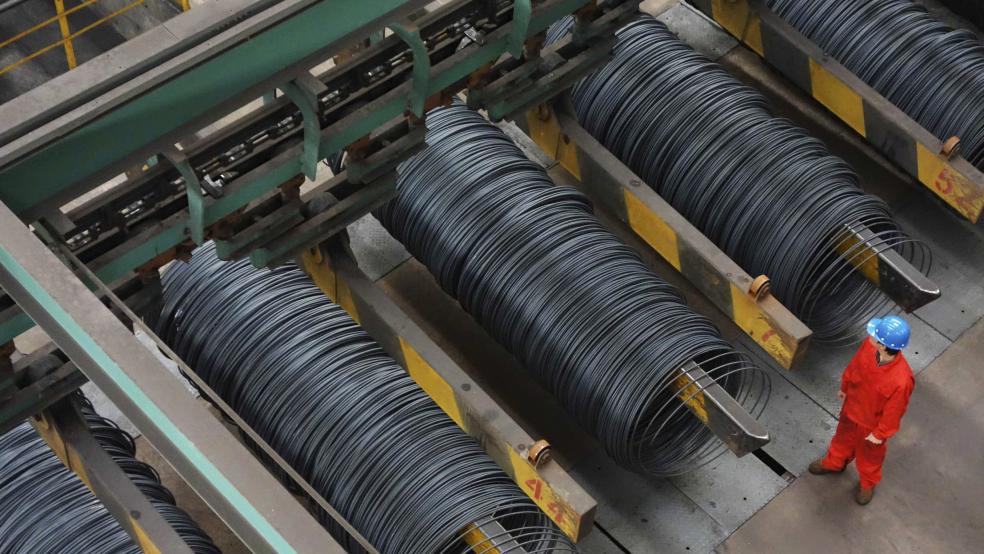The story of Donald Trump’s first 100 days as president could be best told with a flipbook of him holding up executive orders of dubious importance. But one such example last week could prove more significant. Trump opened an investigation into the dumping of cheap steel into the U.S. market, mostly from China. If the Commerce Department confirms this, import restrictions could ensue, including tariffs. “This is not an area where we can afford to become dependent on foreign countries,” Trump said last Thursday.
There Trump goes again, spouting protectionist bluster that will only hurt the economy. That’s the official line, anyway, from the establishment guardians of the discourse. In reality, steel tariffs would be the most normal thing Trump has done yet. The past two presidents imposed steel tariffs, as has virtually every industrialized nation in the world in recent years. That’s because Chinese steel dumping verifiably violates international law. And the argument that we simply have to accept that, as a by-product of having cheap goods, never gets applied to the many other areas protected from competition by the neoliberal consensus. Only middle-class workers have to bear such a burden.
Related: Is China Too Tough a Steel Beast for Trump to Tame?
The issue here is simple. China built hundreds of steel mills in the 1970s to facilitate moving hundreds of millions of people from the countryside into the cities. As internal infrastructure needs dropped, China resisted closing steel mills, and instead exported excess capacity. This dropped the price of steel (though it has since rebounded to about 60 percent of 2012 levels) and made it difficult for other countries to compete. China has promised to close mills and reduce excess capacity, but it still accounts for nearly half of global steel production.
Compounding this, China broke trade laws by selling steel on the international market below the price it sells for at home. This predatory pricing mechanism, known as “dumping,” is intended to achieve market dominance. According to U.S. Steel, rival Chinese manufacturers colluded to fix prices and push competitors out of business. China subsidizes its steel mills, but any other company can’t survive manufacturing steel at a loss. Domestic CEOs have likened this to war.
When dumping occurs, countries can seek World Trade Organization sanctions or initiate tariffs. The U.S. has done both, but trade enforcement sanctions have proven too slow — industries have to suffer for years before getting relief. So tariffs have become more frequent. George W. Bush issued broad tariffs on imported steel in 2002 (he reversed himself a year later, after the European Union threatened retaliation). Barack Obama levied Chinese steel duties in 2010, and they were upheld by the WTO.
Related: Trump 'Buy American' Edict May Have Little Impact on U.S. Steel
Last May, Obama added tariffs as high as 500 percent on “cold-rolled” steel, used in autos and appliances. The EU, which once condemned the U.S. for steel tariffs, added several rounds of its own. And since 2015, nearly 100 different global trade actions have been leveled against China’s steel policies.
Trump’s proposed investigation is a little different. Using the Trade Expansion Act of 1962, the government can make a determination that a particular industry is vital to national security, and therefore impose restrictions on imports. Steel is obviously used in weapons and aircraft. Trade Expansion Act duties have only ever been used in reaction to the 1970s oil crisis. (There’s a rumor that Trump will soon sign an executive order directing a similar investigation into aluminum, which also shows signs of Chinese-created overcapacity.)
It’s legitimate to assess the national security impact on global supply chains integrated with potential rivals. A novel called Ghost Fleet became a must-read at the Pentagon last year, in part because it depicts how over-reliance on multinational corporations and industrial capacity from abroad can backfire. Putting much of our supply chain in the hands of one country grants too much leverage to create artificial scarcity and facilitate collapse. That includes weapons but also rail lines, bridges, electrical generation and other pieces of critical infrastructure, all of which use steel. There are also signs that lightly regulated Chinese steel has significant quality problems.
Related: Business Isn't Happy About Trump's 'Hire American' Executive Order
The first official line from those who oppose tariffs is that these measures don’t work — that cheap steel from China or elsewhere continues to overrun international markets. That’s not actually true. Annual Chinese steel output is expected to shrink by 15 percent over the next three to four years. While China talked tough about the U.S. crackdown, Beijing revoked the licenses of 29 different steel mills days after the Trump order.
Do tariffs necessarily mean more jobs for steelworkers? A typical U.S. steel plant uses far fewer workers today than in the past, thanks to automation. And lower demand for domestic steel affects U.S. jobs, though an infrastructure program would provide a boost. But it’s axiomatic that lowering costs for American steel relative to Chinese rivals would help the industry (and half a million jobs, according to a 2014 Economic Policy Institute report). Plus, I don’t recall the proviso in trade enforcement that violations aren’t important unless they definitively bring the affected industry back to 1960s levels of employment. Anyway, there are lots of other reasons to prevent China’s predatory pricing.
That brings us to the second official line, that tariffs create self-inflicted wounds, raising costs for any company or industry that uses steel. For example, state and local governments won’t see their infrastructure dollars stretch as far if steel costs more. But the single largest cost in infrastructure is the financing, roughly one-half of the total amount. These same free traders tut-tutting over steel costs never suggest a single way to reduce financing costs, like by chartering state-owned banks that re-route interest gains back into local economies.
Related: China Clamps Down on Excess Steel as Japan Decries Trump 'Protectionism'
These blind spots consistently hold in discussions of trade policy. America must follow established rules and open its markets to foreign competition. But if a competitor breaks those rules, there’s nothing to be done, because fighting those violations is counterproductive. This creates a one-way ratchet to destroy working-class manufacturing jobs, in a way that isn’t applied consistently. Economist Dean Baker rigorously points out that protectionism for doctors or other high-earning professionals never gets lifted the way it has for middle-class workers.
The “there is no alternative” narrative about globalization forces artificial constraints on public policy. Cutting doctor salaries would lower health care costs across the system and save tens of thousands of jobs. But only with respect to steel are the costs of invigorating domestic industry described in terms of job destruction. Multinational corporations that prefer the status quo of squeezing labor and materials costs like to be able to sell out American industry; they don’t like their friends in the professional classes to have to give up a dime.
If you overlook demonstrably harmful trade violations because the cheap products that result are good for some company’s bottom line, you make it easier for a country like China to aggressively flout the next set of regulations, and the next. Thousands of steel jobs aren’t as much the point here as it is the millions of other jobs dependent on a trade system with a level playing field.
We’ll see if Trump’s directive leads to action on the steel industry. But the idea that you can’t save a steelworker’s job from the “natural” forces of globalization is ridiculous. There are biases and predispositions imposed on the entire allegedly neutral structure. The hand is not invisible. In fact, it protects the well-connected from any real constraint on their quest for riches.






